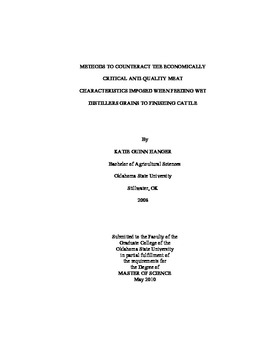| dc.description.abstract | The objective of this study was to determine the impact that pre-harvest anti-oxidant supplementation to cattle fed wet distiller's grains has on not only carcass yield and quality grade, but also color stability and consumer acceptability. Two hundred and forty crossbred steers were fed 35% wet distiller's grains with the supplementation of four different levels of vitamin E: 0 IU/hd/d (CON), 125 IU/hd/d, 250 IU/hd/d, and 500 IU/hd/d for 97 d. Chuck rolls (n = 69) and strip loins (n = 185) were collected and processed on 4 d and 7 d, post harvest. Chucks were ground and separated into 0.23 kg samples. Strip loins were faced and cut into 2.54 cm steaks and packaged in either polyvinyl chloride overwrapped (PVC) package, a vacuum package, or modified atmosphere packages (MAP), for further color, alpha-tocopherol, Thiobarbituric Acid Reactive Substance (TBAR), tenderness and palatability analysis, and proximate analysis. Color was measured objectively using a HunterLab Miniscan XE, subjectively by a trained color panel, and a consumer panel was utilized to indicate which treatments impacted retail acceptability and purchase decisions. Warner-Bratzler Shear Force (WBSF) measurements were used for objective tenderness, and a trained panel assessed subjective tenderness and palatability. Instrumental color measurements revealed little difference for ground beef in both PVC and MAP packages, but diets with 500 IU/hd/d and 250 IU/hd/d inclusion levels of vitamin E showed significant (P < 0.05) increases in redness and yellowness retention in steaks. Subjective color evaluation for strip steaks indicated that higher levels of vitamin E were more likely to maintain color stability (P < 0.01), overall acceptability, and consumer purchase preference, while decreasing % discoloration (P < 0.0001). No significant differences were observed for objective tenderness and sensory attributes of strip steaks, and there was no difference in protein, fat, or moisture percent of ground beef. Lipid oxidation analysis indicated that steaks packaged in PVC for 7 d and MAP for 1 d, 3 d, and 7 d, and ground beef in MAP and PVC for 0 and 7 d of retail display, required higher inclusion levels of vitamin E (500 IU/hd/d and 250 IU/hd/d) to remain below the 2.28 mg malonaldehyde/kg threshold. Ultimately, 500 IU/hd/d of vitamin E should be supplemented to beef distiller's grain base diets and products packaged in MAP to maximize retail shelf life retention. | |
